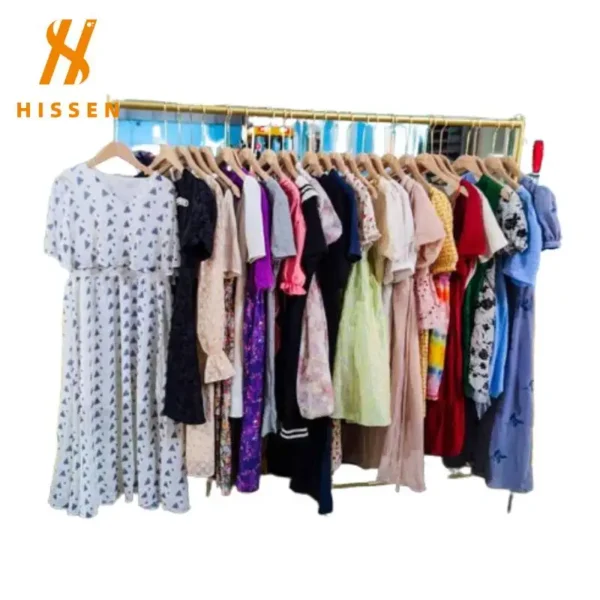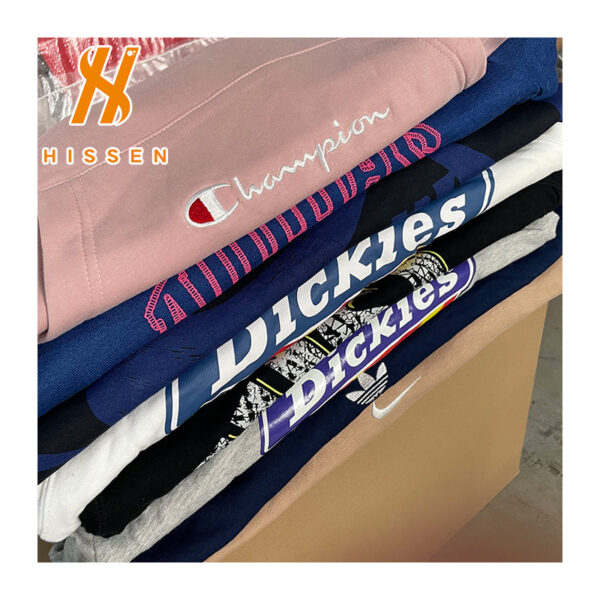I. Introduction
In recent years, the global apparel industry has undergone a profound transformation. Alongside the rapid rise and subsequent slowdown of fast fashion, a new force has been shaping consumption patterns: the secondhand clothing sector. Among the most dynamic elements within this sector is the growing demand for branded clothing bales, which primarily consist of pre-owned garments from well-known fast fashion labels.
Unlike generic secondhand clothing, branded bales are valued because they contain apparel that buyers and end consumers recognize, trust, and associate with consistent quality. In the context of international trade and wholesale distribution, these bales have become a key commodity, linking recycling systems in developed economies with new consumer demand in emerging and established markets.
The importance of branded clothing bales extends beyond cost-effectiveness. They embody the convergence of sustainability, consumer preference, and global supply chain efficiency. For wholesale buyers, retailers, and distributors, the trade in branded clothing bales presents a significant opportunity to meet growing demand while aligning with global trends in circular fashion.
This article examines the global market landscape for branded clothing bales, focusing on why demand is accelerating, where the most promising regions lie, and what opportunities exist for B2B distributors seeking to expand in this sector.
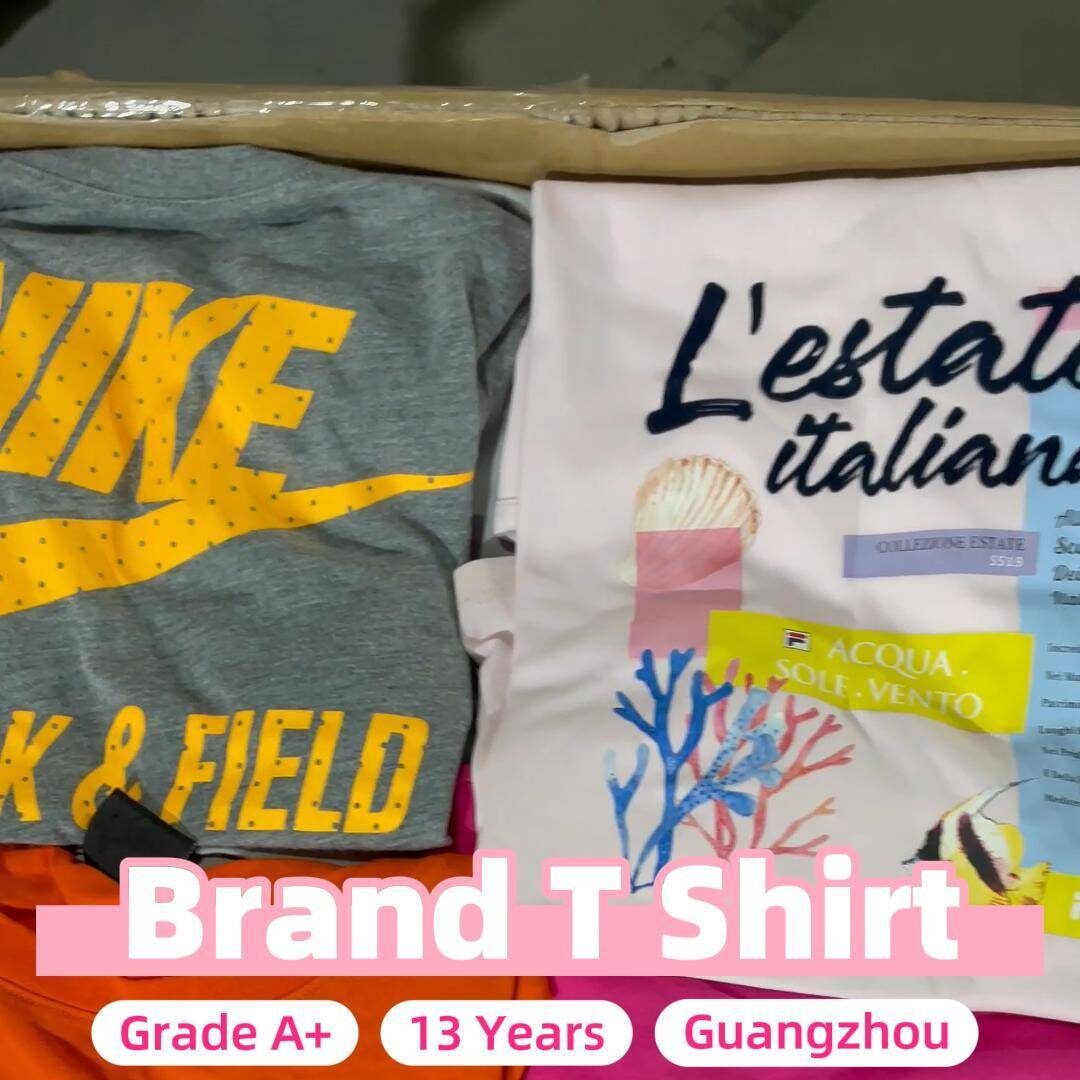
II. Global Overview of the Branded Secondhand Clothing Market
Definition of Branded Clothing Bales
Branded clothing bales refer to compressed bundles of pre-owned garments, typically sourced from fast fashion retailers and recycling systems. They differ from mixed or unbranded bales by featuring apparel originally produced by recognizable fashion chains. For B2B buyers, this distinction matters because it provides assurance of consistent product quality, recognizable designs, and greater consumer acceptance.
In the wholesale trade, branded clothing bales are particularly attractive because they reduce uncertainty in sourcing. When a distributor purchases such bales, they are not simply acquiring fabric or anonymous garments; they are investing in items that carry established market appeal.
Global Market Trends
The secondhand clothing industry has shifted from being a peripheral, low-cost alternative to becoming a mainstream and strategic component of the global fashion ecosystem. Several factors have contributed to this shift:
Sustainable consumption: Growing awareness of environmental impact has made secondhand fashion more acceptable and even desirable.
Fast fashion fatigue: Consumers are increasingly aware of overproduction and its ecological consequences, leading to higher demand for reuse and recycling.
Digital resale platforms: Online marketplaces have normalized the purchase of pre-owned apparel, helping to legitimize branded clothing bales as part of the retail cycle.
This evolution has positioned branded clothing bales not merely as surplus or waste, but as an integral part of the circular economy.
Role in the Global Textile Supply Chain
The apparel industry is one of the largest contributors to textile waste worldwide. Branded clothing bales play a critical role in reducing this waste, extending the lifespan of garments, and creating new value chains. By facilitating redistribution across borders, they allow unsold or lightly used apparel to reach consumers who value affordability, style, and sustainability.
For B2B distributors, branded clothing bales are not just a commodity—they represent participation in a global movement toward responsible trade. This market sits at the intersection of economic opportunity and environmental stewardship, making it particularly relevant for wholesale operators looking to future-proof their businesses.
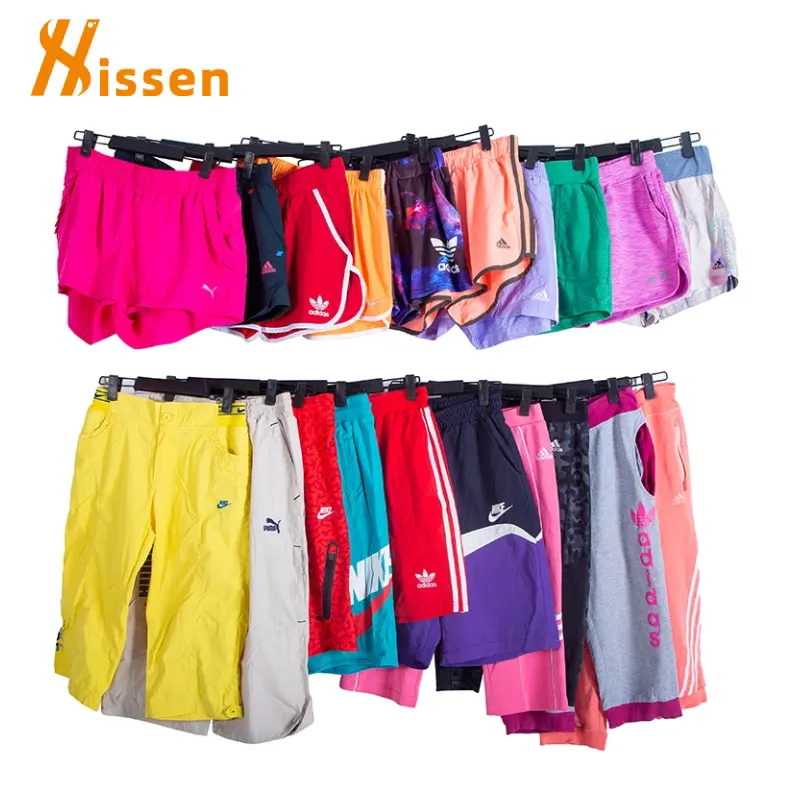
III. Core Reasons Driving Global Demand
The demand for branded clothing bales in the global market can be explained by several interconnected drivers. Understanding these factors is essential for B2B buyers who want to evaluate long-term opportunities.
Price Advantage
At the wholesale level, price remains the single most decisive factor. Branded clothing bales offer distributors and retailers access to garments at a fraction of the cost of new apparel. This cost advantage creates wider profit margins and allows operators to serve budget-conscious markets effectively.
In many regions, end consumers are highly price-sensitive, yet they still aspire to own branded clothing. The ability to supply branded apparel at lower prices creates a win-win situation for both distributors and consumers.
Brand Recognition and Consumer Preference
One of the most powerful drivers is brand familiarity. Even when garments are secondhand, consumers often prefer pieces from international fast fashion labels because they recognize the name, associate it with quality, and trust the design consistency.
For wholesalers and retailers, offering branded clothing bales reduces the barrier to sale. Rather than convincing customers of quality, distributors can rely on established perceptions. This dynamic is particularly important in markets where international labels enjoy aspirational value.
Sustainability and Circular Economy
Environmental awareness is no longer limited to niche markets. Across regions, governments, organizations, and consumers are embracing the principles of recycling and circular fashion. Branded clothing bales align perfectly with this ethos, as they directly reduce waste, minimize resource consumption, and extend product life cycles.
For B2B buyers, sourcing branded clothing bales is not just an economic decision but also a strategic move to align with sustainability narratives. Distributors who can market their business as both affordable and environmentally responsible gain a competitive advantage.
Quality and Durability
Compared to unbranded or anonymous secondhand garments, fast fashion brand clothing often offers a higher baseline of quality. While not luxury, these items typically have consistent sizing, stitching, and fabric standards. This makes branded clothing bales more reliable for resellers, as fewer items are damaged or unsellable.
For wholesale distributors, consistency is crucial. Branded clothing bales help ensure that end customers receive products that meet their expectations, reducing risk for retailers and maintaining trust in the supply chain.

IV. Regional Market Overview
The demand for branded clothing bales is not uniform worldwide. Different regions exhibit unique consumption behaviors, distribution structures, and cultural attitudes toward secondhand apparel. For B2B distributors, understanding these distinctions is key to targeting the right markets.
North America
In North America, secondhand fashion has moved far beyond thrift shops. A mature culture of resale and recycling has created an environment where branded clothing bales thrive.
Consumer culture: There is widespread acceptance of secondhand apparel, particularly among younger demographics who see it as both cost-effective and environmentally responsible.
Digital platforms: Online resale platforms and wholesale marketplaces have expanded access to branded bales, making cross-border trade more seamless.
B2B opportunities: Distributors can take advantage of strong logistics networks and high consumer awareness. Wholesale buyers find a ready market not only domestically but also for export to regions that source from North America.
For B2B suppliers, North America represents a highly competitive yet rewarding market, where efficiency and branding of the resale concept matter as much as the product itself.
Europe
Europe has become a hub for sustainable fashion practices, and the demand for branded clothing bales reflects this trend.
Regulatory environment: European governments have introduced policies to encourage textile recycling and reduce waste, indirectly boosting the secondhand market.
Retail integration: Unlike in some regions, secondhand clothing in Europe is not limited to informal markets. Established retailers increasingly integrate pre-owned clothing into their offerings.
Consumer preference: European consumers often value sustainability alongside affordability, making branded clothing bales a natural fit.
For wholesalers, Europe provides both a strong domestic resale market and a critical sourcing hub. Many branded clothing bales originate from European collection systems before being exported to other regions.
East Asia
East Asia presents one of the fastest-growing markets for branded clothing bales, driven by urban consumer demand and shifting cultural attitudes.
Urban demographics: Rising middle-class populations in cities show strong interest in affordable branded fashion, making secondhand options highly attractive.
Youth culture: Younger consumers are particularly engaged with the value proposition of branded clothing bales. They appreciate both the cost savings and the alignment with global sustainability values.
Retail diversity: From wholesale markets to e-commerce channels, the distribution of branded bales in East Asia is becoming more diversified and accessible.
For B2B buyers, East Asia offers high growth potential but requires adaptability. Distributors must align with local retail formats and consumer expectations to succeed.
Other Regions (Latin America and Emerging Markets)
While not as developed as North America, Europe, or East Asia, regions such as Latin America and parts of Africa and Southeast Asia are steadily increasing their demand for branded clothing bales. These markets are typically price-driven, and branded apparel provides both affordability and aspirational value.
For wholesalers, entering these regions often means navigating less structured supply chains but enjoying the advantage of high-volume demand.

V. Supply Chain and Distribution Channels of Branded Clothing Bales
The supply chain of branded clothing bales is both complex and globally interconnected, spanning collection, sorting, packaging, and distribution. For B2B buyers and distributors, understanding each step of this process is crucial to ensuring reliability, consistency, and profitability.
Sources of Branded Clothing Bales
The origins of branded clothing bales can be traced to several main sources, which together sustain a steady flow of pre-owned garments:
Retail Returns and Excess Stock: Apparel returned by customers or excess stock that cannot be sold in primary markets often enters secondary channels. These items are frequently in near-new condition, making them highly attractive when processed into bales.
Clearance and Overstocks: Fast-moving consumer apparel is produced at scale, which inevitably creates unsold inventory after each fashion cycle. Rather than discarding these items, many suppliers channel them into wholesale bale systems, providing a steady supply to international buyers.
Seasonal and Out-of-Season Garments: Apparel tied to specific fashion seasons is often rotated quickly. Once it is no longer relevant in its original market, it is repurposed through the bale system for resale in other regions where seasonality differs or where the timing still creates demand.
Collection and Recycling Programs: Increasingly, retailers and organizations implement take-back programs where consumers return used garments. These are aggregated, sorted, and processed into branded bales, contributing to the circular fashion ecosystem.
For B2B buyers, the key advantage is that branded clothing bales come from structured supply channels rather than unregulated sources. This ensures consistency and helps buyers manage expectations. For bulk buyers, partnering directly with a reliable branded clothing bales manufacturer ensures consistency, quality, and timely supply in competitive markets.
Supply Chain Process
The journey from collection point to export-ready bale involves multiple steps:
Collection: Garments are sourced from retailers, donation centers, and recycling programs.
Sorting: Specialized facilities sort clothing by category, quality, and brand relevance, ensuring that bales meet expectations.
Grading: While parameters may differ, many facilities classify garments into broad quality tiers, ensuring buyers know the general level of wear and usability.
Baling and Packaging: Clothing is compressed into manageable bundles, ready for shipment. Packaging is designed for efficient transport and storage.
Export Logistics: Branded clothing bales are transported via shipping routes to wholesale buyers across global markets.
This streamlined process reduces costs while maximizing volume efficiency, making it attractive for bulk purchasing.
Distribution Channels
Once branded clothing bales reach their destination, they move through diverse distribution channels tailored to regional consumer habits. These include:
Wholesale Markets: Traditional wholesale hubs serve as the primary entry point, allowing bulk buyers to purchase and redistribute within local markets. Many international buyers prefer to engage in branded clothing bales wholesale transactions, as it simplifies sourcing and allows greater flexibility in resale strategies.
Retail Shops: Many retailers rely on branded bales as their core supply, offering customers branded apparel at affordable prices.
Online Platforms: Digital marketplaces have become increasingly important, enabling even small-scale retailers to tap into international bale supply chains.
Export Redistribution: Some buyers purchase branded clothing bales from one region and re-export them to other markets where demand is stronger.
For B2B buyers, flexibility in distribution channels is a key advantage. Depending on infrastructure, they can serve different tiers of consumers, from urban boutiques to rural retail markets.
Strategic Importance for B2B Buyers
The supply chain and distribution ecosystem for branded clothing bales is more than logistics—it is a competitive differentiator. Buyers who establish strong relationships with reliable suppliers and logistics providers gain consistency in quality and supply. Moreover, distributors who understand multiple sales channels can adapt quickly to market shifts, ensuring long-term sustainability.
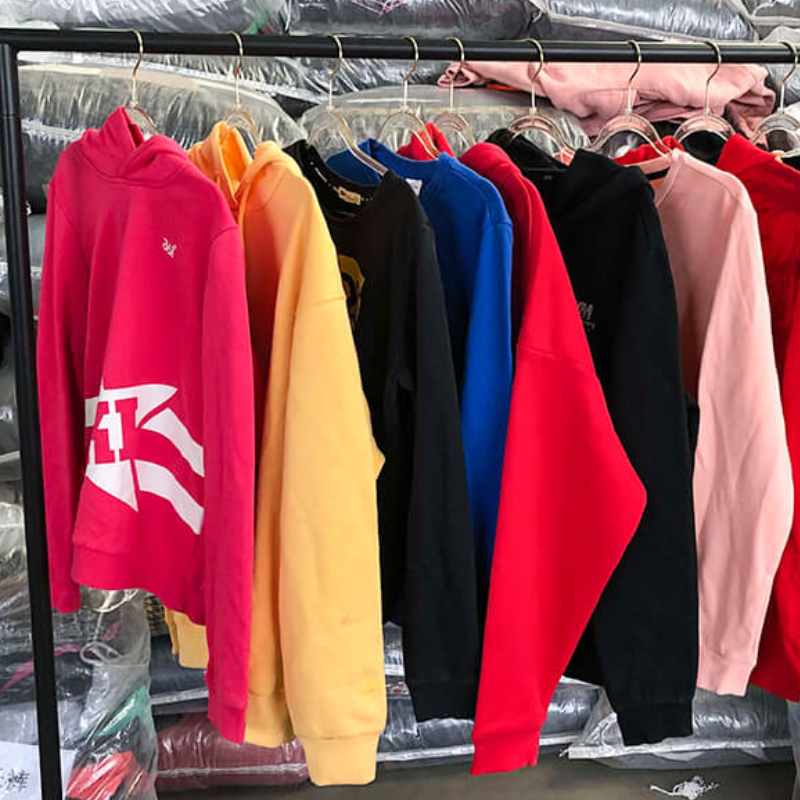
VI. Market Development Trends and Future Opportunities
The global demand for branded clothing bales is not static. It continues to evolve, shaped by broader shifts in technology, consumer behavior, and regulation. For B2B distributors, anticipating these trends is vital to staying competitive.
Digitalization and Cross-Border E-Commerce
One of the most profound shifts is the digital transformation of wholesale and retail trade. E-commerce platforms have expanded from consumer sales to include B2B transactions, making it easier for international buyers to source branded clothing bales.
Global Reach: Buyers no longer need to rely solely on local suppliers; they can directly connect with exporters worldwide.
Efficiency: Digital platforms streamline order management, shipping, and payments, reducing transaction costs.
Transparency: Online marketplaces often include ratings and certifications, helping buyers evaluate supplier reliability.
For distributors, investing in digital capabilities is not optional—it is essential. Cross-border e-commerce is reshaping how branded clothing bales move, making it easier to scale and diversify supply chains.
Emerging Market Potential
While established markets in North America, Europe, and East Asia are strong, emerging regions represent untapped growth opportunities.
Latin America: Rapid urbanization and increasing consumer appetite for affordable branded apparel create demand for bulk imports of branded clothing bales.
Southeast Asia: Beyond major economies, secondary cities and rural markets are increasingly receptive to branded secondhand clothing, offering high-volume sales potential.
Africa: With a young and price-conscious population, Africa continues to be one of the largest importers of secondhand apparel, including branded bales.
For B2B distributors, entering emerging markets requires understanding local infrastructure and regulatory environments. While challenges exist, the potential for growth is substantial.
Opportunities for Distributors
Distributors of branded clothing bales stand at a strategic crossroads. Several opportunities exist to strengthen their position:
Scale and Volume Expansion: By leveraging global supply networks, distributors can increase the volume of bales they handle, reducing unit costs and improving margins.
Platform-Based Distribution: Building or joining digital wholesale platforms allows distributors to reach new buyers worldwide.
Value-Added Services: Beyond simple resale, distributors can provide sorting, re-packaging, or branding services, adding differentiation in a competitive market.
International Partnerships: Collaboration with logistics firms, recycling organizations, and retail chains can create more stable supply flows.
For buyers, these opportunities translate into more choices and improved supply reliability.
Challenges and Considerations
While opportunities abound, the branded clothing bale market also faces significant challenges:
Standardization: Variations in grading and sorting create uncertainty for buyers. Establishing more consistent standards would benefit the entire industry.
Regulatory Oversight: Governments are increasingly regulating secondhand imports to manage waste and protect local industries. Navigating these rules requires expertise.
Quality Assurance: Ensuring that branded bales consistently meet buyer expectations is critical. Any compromise in quality undermines trust and long-term relationships.
Supply Chain Complexity: Global logistics remain subject to disruptions, from transportation bottlenecks to changing trade policies.
B2B buyers who plan for these challenges can turn them into competitive advantages by adopting rigorous supplier evaluation, compliance monitoring, and logistics planning.
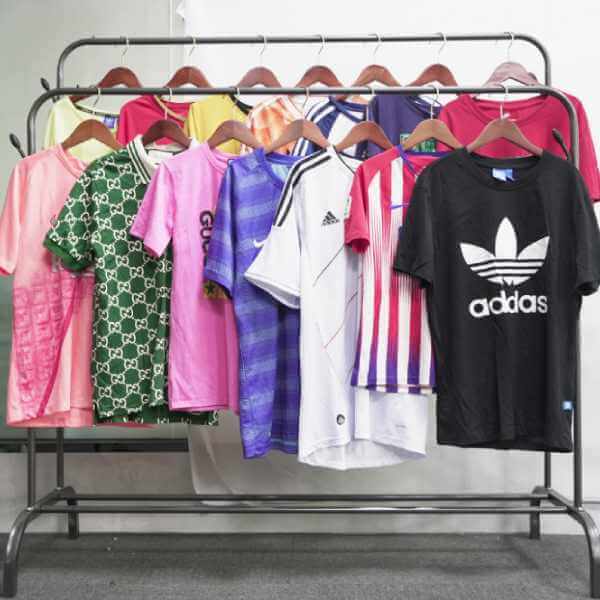
VII. Conclusion
The global demand for branded clothing bales reflects a profound shift in the apparel industry. What began as a surplus solution for fast fashion has evolved into a global trade system that balances affordability, sustainability, and consumer preference.
For B2B buyers, branded clothing bales offer more than just cost savings. They represent access to a commodity that is recognized, valued, and increasingly aligned with global sustainability objectives. By understanding the supply chain, leveraging digital platforms, and targeting both established and emerging markets, distributors can position themselves at the forefront of a rapidly expanding sector.
The continued growth of branded clothing bales underscores the value of circular fashion. Distributors who invest in strong supply partnerships, diversify their channels, and maintain a focus on quality will find long-term opportunities in this market. At the same time, they will contribute to reducing textile waste and advancing more sustainable global trade practices.
Ultimately, branded clothing bales are not merely products—they are a strategic asset. For wholesalers, retailers, and exporters, they offer a pathway to profitability, resilience, and alignment with the future of global fashion.

